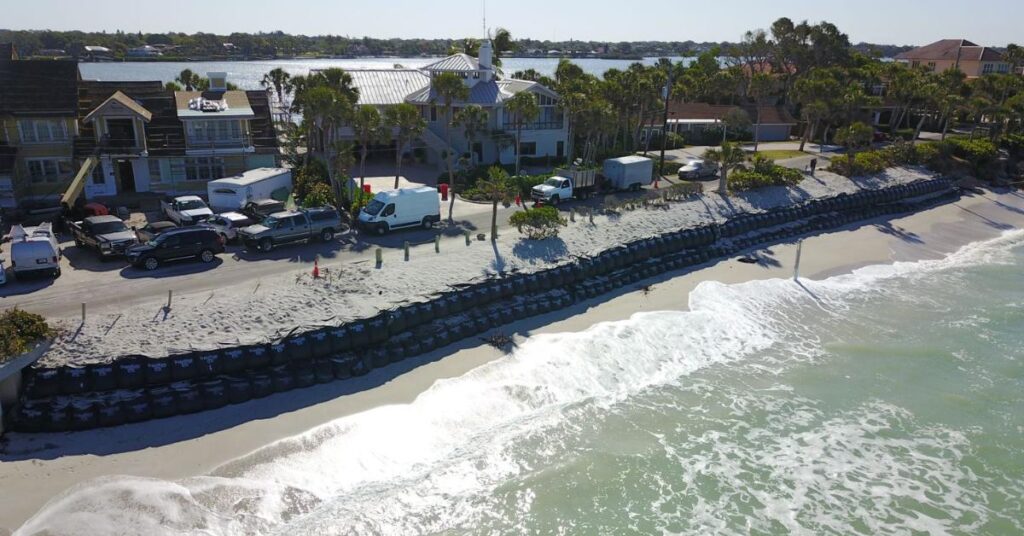Concrete Retaining Walls for Shoreline Erosion Control
Concrete retaining walls are an excellent erosion control solution for coastal property owners who want to protect their shoreline from eroding away.

Erosion: It’s a natural process with multiple benefits for soil health, but it can also be a nightmare for shorefront property owners. However, there are solutions for preventing erosion from damaging your home, business, or other structures.
Discover some common shoreline erosion control solutions, and how concrete retaining walls can play a role in protecting your property.
What Causes Shoreline Erosion?
There are multiple factors that contribute to shoreline erosion. Some of these are the result of human activities, while others are due to natural occurrences. Here are some of the most common causes of shoreline erosion, both near oceans and lakes:
- Plant displacement: Removal of shore grass, shrubs, and trees along the coastline leaves the sand and soil vulnerable to wind, rain, and waves.
- Land development: Building homes, roads, and other structures near the shorefront destabilizes the soil on the shoreline, making erosion more likely.
- Wind exposure: As a natural byproduct of being exposed to the air, shorelines are more likely to experience wind-driven erosion that affects both beaches and cliffs.
- Rain, waves, and snow: Whether from persistent rainstorms, constant effects of the tide, or frost wedging in colder locales, water causes shoreline erosion in multiple ways, especially if the beach separating the land and water is wearing thin.
Erosion is a natural geological process that has multiple benefits. However, it can also cause property damage when left unchecked, or when structures and highways are built too close to the shoreline.
How to Control Beach Erosion
Preserve Vegetation
While some property owners might find beach grass unsightly and opt to have a beach grooming service remove it, plants play an essential role in anchoring the sand and soil into place. Preserving shrubs like beach cabbage, sea oats, or other vegetation allows your shore to stay protected from wind and water exposure, helping it last longer and keeping your property safe.
If you choose to plant more vegetation around the shoreline, be sure to use local and endemic plants and shrubbery. Not only will these be more likely to thrive, but they could prevent invasive plants from taking root in your area.
Prevent Surface Runoff from Reaching the Shore
If you own or manage shorefront or beachfront property, you may have noticed that water from your house’s gutters or your driveway can drain downward toward the shoreline. This seepage of rainwater and snowmelt runoff can directly contribute to beach erosion.
There are several ways to prevent this type of erosion, but two of the best options include setting up a rain barrel underneath the main drainage points on your property or diverting the water toward your city’s storm drains.
Install Berms Near Shore
An underwater berm is a raised structure that affects the way waves hit the shore, typically by making them less forceful. In turn, the berm prevents sand from being swept away from the shore, nourishing the beach and reducing the rate of erosion.
Depending on your property’s circumstances, recruiting a dredging service to install a berm may be a way for you to keep excessive runoff away from the shoreline while allowing the beach to recover on its own. However, please check local regulations before installation.
How to Fix Shoreline Erosion
Water Runoff Diversions
Diverting free-flowing water away from the shoreline not only protects the beaches and bluffs from additional erosion, but may also allow the sand to replenish itself more easily than it would otherwise be able to.
What these diversions might look like depends on your property’s unique circumstances. For example, setting up a swale may be helpful if your property gets heavy rain. However, if you get less consistent rainfall throughout the year, using a cistern or rain barrel could capture water while having the added bonus of giving you an easy way to water your garden.
Some homeowners might also prefer to install a French drain, which is an underground drainage point that looks like a small grate installed in a low-lying area on your property. This grate drains down into a suitable outlet point, keeping the rest of your property dry and safe from erosion.
Erosion Blankets
Erosion control blankets are a common sight in construction areas. They protect the soil around the shoreline from wearing away by keeping the soil beneath them separated from water that may come from tides or storms. Additionally, these blankets are designed to allow plants and vegetation to take root without the soil shifting, further preventing erosion over time.
There are multiple varieties of erosion blankets, which can be made of anything from coconut fibers to wheat straw or synthetic and concrete-blend fibers.
Beach Nourishment
Since it can be prohibitively expensive and risky when implemented incorrectly, beach nourishment is often considered a last resort when deciding how to control beach erosion.
The process of beach nourishment involves finding as precise of a match as possible to use as filler material, then spreading large quantities of it along the existing shoreline. While it is possible to find sand with similar mineral composition and grain size, especially from neighboring beaches, doing so can be tricky—and can lead to the sand being washed back out into the water anyway.
Concrete Retaining Walls
Sometimes called concrete seawalls or embankments, erosion control and construction firms will typically build retaining walls parallel to the beach and waterline. These coastal retaining walls are designed to resist wind and water, stabilizing bluffs, cliffs, and other coastal features.
Shoreline retaining walls typically come in three designs:
- Gravity retaining walls: These are built in a vertical shape and use their own weight to prevent soil from shifting.
- Anchored retaining walls: As the name implies, these concrete seawalls have ground anchors to keep both them and the soil they’re retaining stabilized.
- Cantilever retaining walls: Typically resting on a slab foundation, cantilever retaining walls have an L-shaped design that uses the very force of the soil it’s retaining to keep it in place.
How to Install a Concrete Retaining Wall with TrapBag®
TrapBag makes an excellent base for a concrete retaining wall, in addition to acting as a seawall in its own right. Since they’re easy to install on site, homeowners can easily set up their own TrapBag barrier as a shoreline erosion control solution.
1. Open the Barrier Packaging
The entire TrapBag erosion retention barrier comes folded like an accordion. Stretch the barrier out to its desired length in the shape you need, up to 50 feet.
2. Fill the Cells
This can be done either manually with shovels and buckets, or all at once if you have a bulldozer or backhoe. Sand, concrete, or washed gravel make the best filler materials for TrapBag.
3. Place or Stack the Barrier Where Needed
Filled TrapBags can be set as freestanding barriers, set against existing retaining walls or structures for reinforcement, or stacked on top of each other for additional support.
Protect Your Coastal Property with a TrapBag Concrete Retaining Wall
To see how TrapBag barriers can work alongside concrete retaining walls as a shoreline erosion control solution, view our products or contact us on our website today.
Meet the author
Get the Dirt Before the Flood Hits
Stay ahead of flooding, erosion, and disaster response challenges. The Dirt, TrapBag’s monthly newsletter, delivers field-tested tips, real-world case studies, and the latest in barrier technology straight to your inbox.

